SNAS305J July 2005 – March 2016 ADC121S021
PRODUCTION DATA.
- 1 Features
- 2 Applications
- 3 Description
- 4 Revision History
- 5 Device Comparison Table
- 6 Pin Configuration and Functions
- 7 Specifications
- 8 Parameter Measurement Information
- 9 Detailed Description
- 10Applications Information
- 11Power Supply Recommendations
- 12Layout
- 13Device and Documentation Support
- 14Mechanical, Packaging, and Orderable Information
Package Options
Mechanical Data (Package|Pins)
Thermal pad, mechanical data (Package|Pins)
Orderable Information
7 Specifications
7.1 Absolute Maximum Ratings
over operating free-air temperature range (unless otherwise noted)(1)(2)(3)| MIN | MAX | UNIT | |
|---|---|---|---|
| Analog supply voltage, VA | –0.3 | 6.5 | V |
| Voltage on any digital pin to GND | –0.3 | 6.5 | V |
| Voltage on any analog pin to GND | –0.3 | VA + 0.3 | V |
| Input current at any pin(4) | ±10 mA | mA | |
| Package input current(4) | ±20 mA | mA | |
| Power consumption at TA = 25°C | See (5) | ||
| Junction temperature, TJ | 150 | °C | |
| Storage temperature, Tstg | –65 | 150 | °C |
(1) Stresses beyond those listed under Absolute Maximum Ratings may cause permanent damage to the device. These are stress ratings only, which do not imply functional operation of the device at these or any other conditions beyond those indicated under Recommended Operating Conditions. Exposure to absolute-maximum-rated conditions for extended periods may affect device reliability.
(2) If Military/Aerospace specified devices are required, please contact the TI Sales Office/ Distributors for availability and specifications.
(3) All voltages are measured with respect to GND = 0 V, unless otherwise specified.
(4) When the input voltage at any pin exceeds the power supply (that is, VIN < GND or VIN > VA), the current at that pin must be limited to 10 mA. The 20-mA maximum package input current rating limits the number of pins that can safely exceed the power supplies with an input current of 10 mA to two. The absolute maximum rating specification does not apply to the VA pin. The current into the VA pin is limited by the Analog Supply Voltage specification.
(5) The absolute maximum junction temperature (TJmax) for this device is 150°C. The maximum allowable power dissipation is dictated by TJmax, the junction-to-ambient thermal resistance (RθJA), and the ambient temperature (TA), and can be calculated using the formula PDmax = (TJmax – TA) / RθJA. The values for maximum power dissipation listed above is reached only when the device is operated in a severe fault condition (for example, when input or output pins are driven beyond the power supply voltages, or the power supply polarity is reversed). Obviously, such conditions must always be avoided.
7.2 ESD Ratings
| VALUE | UNIT | |||
|---|---|---|---|---|
| V(ESD) | Electrostatic discharge | Human-body model (HBM), per ANSI/ESDA/JEDEC JS-001(1)(2) | ±3500 | V |
| Charged-device model (CDM), per JEDEC specification JESD22-C101(3) | ±1250 | |||
| Machine mode (MM)(4) | ±300 | |||
(1) JEDEC document JEP155 states that 500-V HBM allows safe manufacturing with a standard ESD control process.
(2) HBM is 100-pF capacitor discharged through a 1.5-kΩ resistor.
(3) JEDEC document JEP157 states that 250-V CDM allows safe manufacturing with a standard ESD control process.
(4) Machine model is 220-pF discharged through 0 Ω.
7.3 Recommended Operating Conditions
over operating free-air temperature range (unless otherwise noted)(1)| MIN | MAX | UNIT | |
|---|---|---|---|
| Operating temperature, TA | –40 | 85 | °C |
| Supply voltage, VA | 2.7 | 5.25 | V |
| Digital input pins voltage(2) | –0.3 | 5.25 | V |
| Analog input pins voltage | 0 | VA | V |
| Clock frequency | 0.025 | 20 | MHz |
| Sample rate | 1 | Msps |
(1) All voltages are measured with respect to GND = 0 V, unless otherwise specified.
(2) Regardless of supply voltage
7.4 Thermal Information
| THERMAL METRIC(1)(2) | ADC121S021 | UNIT | ||
|---|---|---|---|---|
| DBV (SOT-23) | NGF (WSON) | |||
| 6 PINS | 6 PINS | |||
| RθJA | Junction-to-ambient thermal resistance | 185 | 83.7 | °C/W |
| RθJC(top) | Junction-to-case (top) thermal resistance | 156.5 | 72.1 | °C/W |
| RθJB | Junction-to-board thermal resistance | 29.6 | 24.8 | °C/W |
| ψJT | Junction-to-top characterization parameter | 33.8 | 3.4 | °C/W |
| ψJB | Junction-to-board characterization parameter | 29.1 | 24.7 | °C/W |
| RθJC(bot) | Junction-to-case (bottom) thermal resistance | — | 14.8 | °C/W |
(1) For more information about traditional and new thermal metrics, see the Semiconductor and IC Package Thermal Metrics application report, SPRA953.
(2) Soldering process must comply with Reflow Temperature Profile specifications. See http://www.ti.com/lit/SNOA549. Reflow temperature profiles are different for lead-free and non-lead-free packages.
7.5 Electrical Characteristics
VA = 2.7 V to 5.25 V, fSCLK = 1 MHz to 4 MHz, fSAMPLE = 50 ksps to 200 ksps, CL = 15 pF, unless otherwise noted. Typical limits apply for TA = 25°C; minimum and maximum limits apply for TA = –40°C to 85°C, unless otherwise noted. All limits(1)(2)(2)| PARAMETER | TEST CONDITIONS | MIN | TYP | MAX | UNIT | ||
|---|---|---|---|---|---|---|---|
| STATIC CONVERTER CHARACTERISTICS | |||||||
| Resolution with no missing codes |
TA = –40°C to 85°C | 12 | Bits | ||||
| INL | Integral non-linearity | VA = 2.7 V to 3.6 V | TA = 25°C | –0.4 | 0.45 | LSB | |
| TA = –40°C to 85°C | –1 | 1 | |||||
| VA = 4.75 V to 5.25 V | TA = 25°C | –0.4 | 0.55 | LSB | |||
| DNL | Differential non-linearity | VA = 2.7 V to 3.6 V | TA = 25°C | –0.25 | 0.45 | LSB | |
| TA = –40°C to 85°C | –0.8 | 1 | |||||
| VA = 4.75 V to 5.25 V | TA = 25°C | –0.3 | 0.6 | LSB | |||
| VOFF | Offset error | VA = 2.7 V to 3.6 V | –0.18 | ±1.2 | LSB | ||
| VA = 4.75 V to 5.25 V | TA = 25°C | –0.26 | |||||
| GE | Gain error | VA = 2.7 V to 3.6 V | –0.75 | ±1.5 | LSB | ||
| VA = 4.75 V to 5.25 V | TA = 25°C | –1.6 | |||||
| DYNAMIC CONVERTER CHARACTERISTICS | |||||||
| SINAD | Signal-to-noise plus distortion ratio |
VA = 2.7 V to 5.25 V, fIN = 100 kHz, –0.02 dBFS | 70 | 72 | dBFS | ||
| SNR | Signal-to-noise ratio | VA = 2.7 V to 5.25 V, fIN = 100 kHz, –0.02 dBFS | 70.8 | 72.3 | dBFS | ||
| THD | Total harmonic distortion | VA = 2.7 V to 5.25 V, fIN = 100 kHz, –0.02 dBFS | –83 | dBFS | |||
| SFDR | Spurious-free dynamic range | VA = 2.7 V to 5.25 V, fIN = 100 kHz, –0.02 dBFS | 85 | dB | |||
| ENOB | Effective number of bits | VA = 2.7 V to 5.25 V, fIN = 100 kHz, –0.02 dBFS | 11.3 | 11.7 | Bits | ||
| IMD | Intermodulation distortion, second order terms | VA = 5.25 V, fa = 103.5 kHz, fb = 113.5 kHz | –83 | dBFS | |||
| Intermodulation distortion, third order terms |
VA = 5.25 V, fa = 103.5 kHz, fb = 113.5 kHz | –82 | dBFS | ||||
| FPBW | –3-dB full power bandwidth | VA = 5 V | 11 | MHz | |||
| VA = 3 V | 8 | ||||||
| ANALOG INPUT CHARACTERISTICS | |||||||
| VIN | Input range | TA = 25°C | 0 | VA | V | ||
| IDCL | DC leakage current | –1 | 1 | µA | |||
| CINA | Input capacitance | Track Mode | 30 | pF | |||
| Hold Mode | 4 | ||||||
| DIGITAL INPUT CHARACTERISTICS | |||||||
| VIH | Input high voltage | VA = 5.25 V | TA = –40°C to 85°C | 2.4 | V | ||
| VA = 3.6 V | TA = –40°C to 85°C | 2.1 | |||||
| VIL | Input low voltage | VA = 5 V | TA = –40°C to 85°C | 0.8 | V | ||
| VA = 3 V | TA = –40°C to 85°C | 0.4 | |||||
| IIN | Input current | VIN = 0 V or VA | ±0.1 | ±1 | µA | ||
| CIND | Digital input capacitance | 2 | 4 | pF | |||
| DIGITAL OUTPUT CHARACTERISTICS | |||||||
| VOH | Output high voltage | ISOURCE = 200 µA | VA – 0.2 | VA – 0.07 | V | ||
| ISOURCE = 1 mA | VA – 0.1 | ||||||
| VOL | Output low voltage | ISINK = 200 µA | 0.03 | 0.4 | V | ||
| ISINK = 1 mA | 0.1 | ||||||
| IOZH, IOZL | TRI-STATE® leakage current | ±0.1 | ±10 | µA | |||
| COUT | TRI-STATE output capacitance | 2 | 4 | pF | |||
| Output coding | Straight (Natural) Binary | ||||||
| POWER SUPPLY CHARACTERISTICS | |||||||
| VA | Supply voltage | 2.7 | 5.25 | V | |||
| IA | Supply current, normal mode (operational, CS low) |
VA = 5.25 V, fSAMPLE = 200 ksps | 1.5 | 2.8 | mA | ||
| VA = 3.6 V, fSAMPLE = 200 ksps | 0.4 | 1.2 | |||||
| Supply current, shutdown (CS high) |
fSCLK = 0 MHz, VA = 5.25 V, fSAMPLE = 0 ksps | 500 | nA | ||||
| fSCLK = 4 MHz, VA = 5.25 V, fSAMPLE= 0 ksps | 60 | µA | |||||
| PD | Power consumption, normal mode (operational, CS low) |
VA = 5.25 V | 7.9 | 14.7 | mW | ||
| VA = 3.6 V | 1.5 | 4.3 | |||||
| Power consumption, shutdown (CS high) |
fSCLK = 0 MHz, VA = 5.25 V, fSAMPLE = 0 ksps | 2.6 | µW | ||||
| VA = 5.25 V, fSCLK = 4 MHz, fSAMPLE= 0 ksps | 315 | ||||||
| AC ELECTRICAL CHARACTERISTICS | |||||||
| fSCLK | Clock frequency(3) | 1 | 4 | MHz | |||
| fS | Sample rate(3) | 50 | 200 | ksps | |||
| DC | SCLK duty cycle | fSCLK = 4 MHz | 40% | 50% | 60% | ||
| tACQ | Minimum acquisition time | 350 | ns | ||||
| tQUIET | Minimum quiet time(4) | 50 | ns | ||||
| tAD | Aperture delay | 3 | ns | ||||
| tAJ | Aperture jitter | 30 | ps | ||||
(1) Tested limits are specified to TI's AOQL (Average Outgoing Quality Level).
(2) Data sheet min/max specification limits are ensured by design, test, or statistical analysis.
(3) This is the frequency range over which the electrical performance is ensured. The device is functional over a wider range which is specified under Operating Ratings.
(4) Required by bus relinquish and the start of the next conversion.
7.6 Timing Requirements
The following specifications apply for VA = 2.7 V to 5.25 V, GND = 0 V, fSCLK = 1 MHz to 4 MHz, CL = 25 pF, fSAMPLE = 50 ksps to 200 ksps, all limits TA = –40°C to 85°C unless otherwise noted.| MIN | TYP | MAX | UNIT | |||
|---|---|---|---|---|---|---|
| tCS | Minimum CS pulse width | 10 | ns | |||
| tSU | CS to SCLK setup time | 10 | ns | |||
| tEN | Delay from CS until SDATA TRI-STATE disabled(1) | 20 | ns | |||
| tACC | Data access time after SCLK falling edge(2) | VA = 2.7 V to 3.6 V | 40 | ns | ||
| VA = 4.75 V to 5.25 V | 20 | |||||
| tCL | SCLK low pulse width | 0.4 × tSCLK | ns | |||
| tCH | SCLK high pulse width | 0.4 × tSCLK | ||||
| tH | SCLK to data valid hold time | VA = 2.7 V to 3.6 V | 7 | ns | ||
| VA = 4.75 V to 5.25 V | 5 | |||||
| tDIS | SCLK falling edge to SDATA high impedance(3) |
VA = 2.7 V to 3.6 V | 6 | 25 | ns | |
| VA = 4.75 V to 5.25 V | 5 | 25 | ||||
| tPOWER-UP | Power-up time from full power-down | TA = 25°C | 1 | µs | ||
(1) Measured with the timing test circuit shown in Figure 12 and defined as the time taken by the output signal to cross 1 V.
(2) Measured with the timing test circuit shown in Figure 12 and defined as the time taken by the output signal to cross 1 V or 2 V.
(3) tDIS is derived from the time taken by the outputs to change by 0.5 V with the timing test circuit shown in Figure 12. The measured number is then adjusted to remove the effects of charging or discharging the output capacitance. This means that tDIS is the true bus relinquish time, independent of the bus loading.
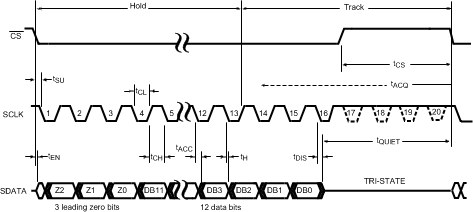 Figure 1. ADC121S021 Serial Timing Diagram
Figure 1. ADC121S021 Serial Timing Diagram
7.7 Typical Characteristics
TA = 25°C, fSAMPLE = 50 ksps to 200 ksps, fSCLK = 1 MHz to 4 MHz, fIN = 100 kHz unless otherwise stated.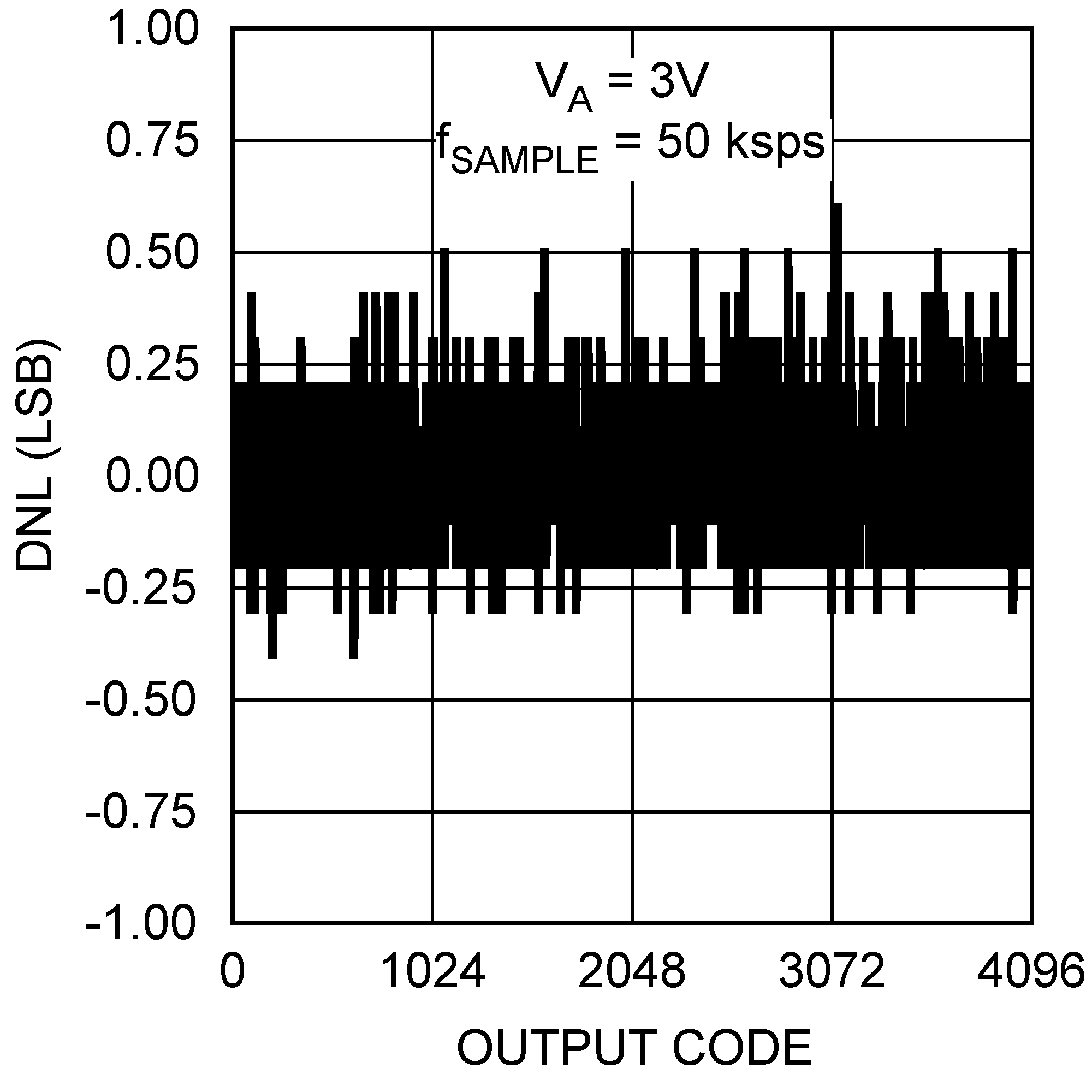
| fSCLK = 1 MHz |
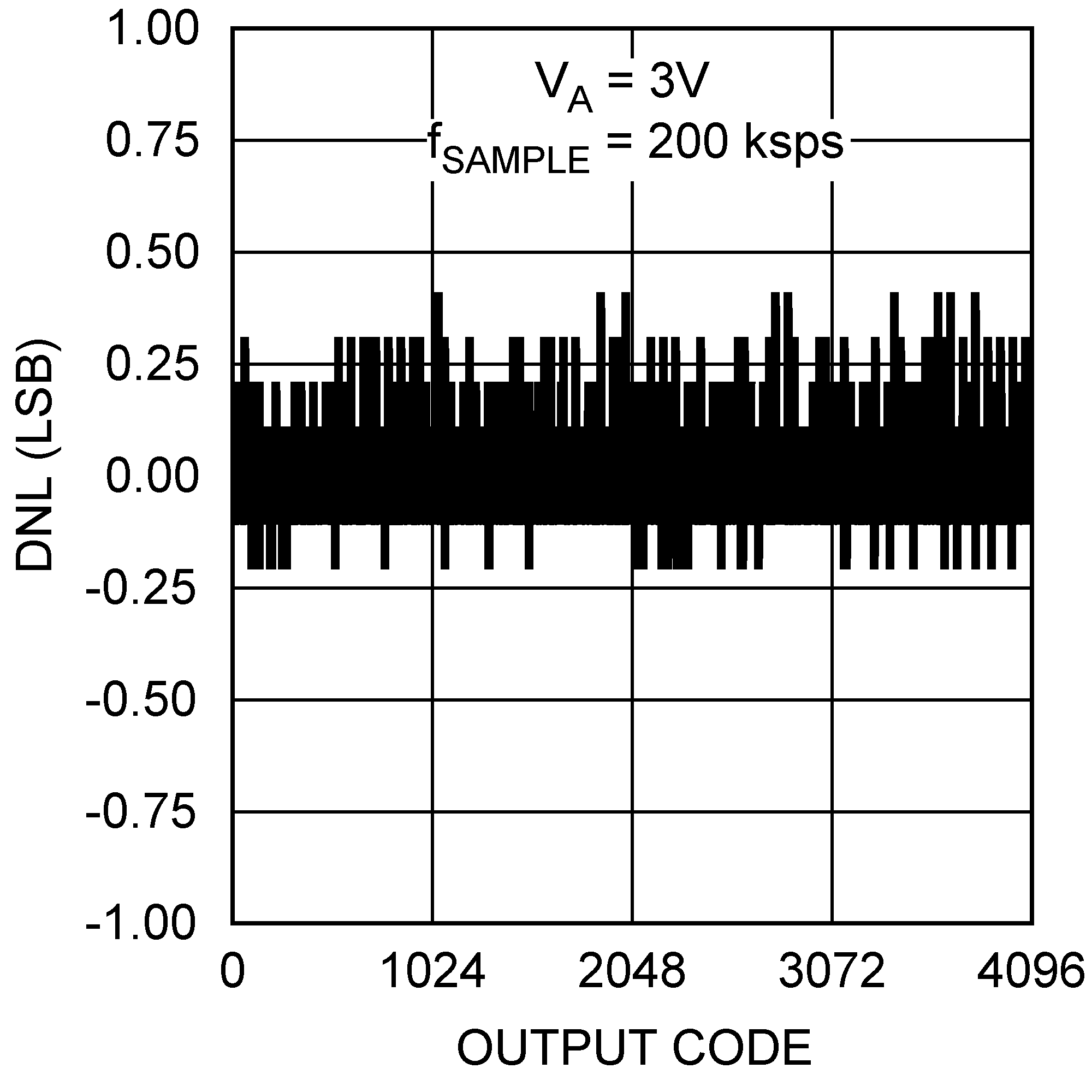
| fSCLK = 4 MHz |
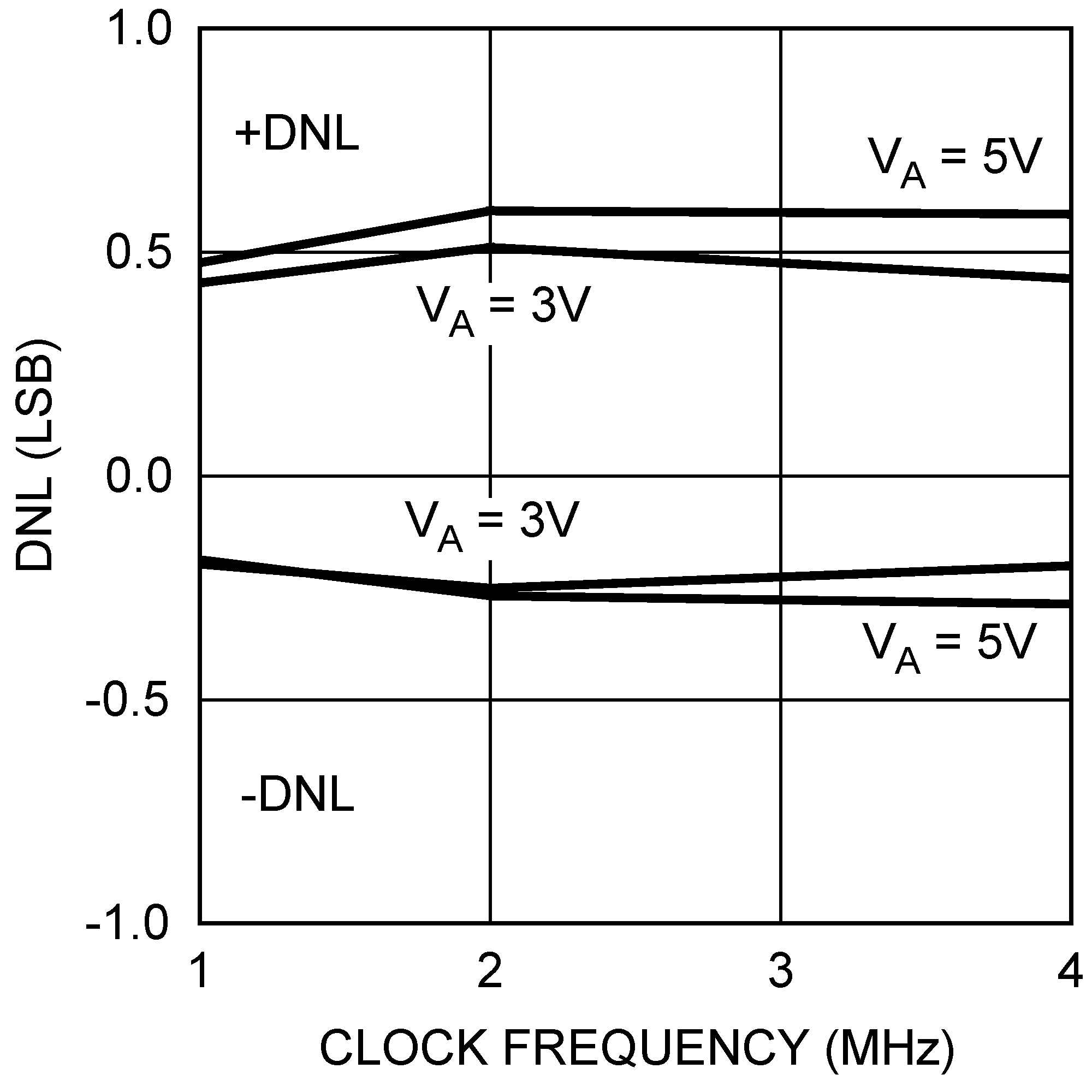 Figure 6. DNL vs Clock Frequency
Figure 6. DNL vs Clock Frequency
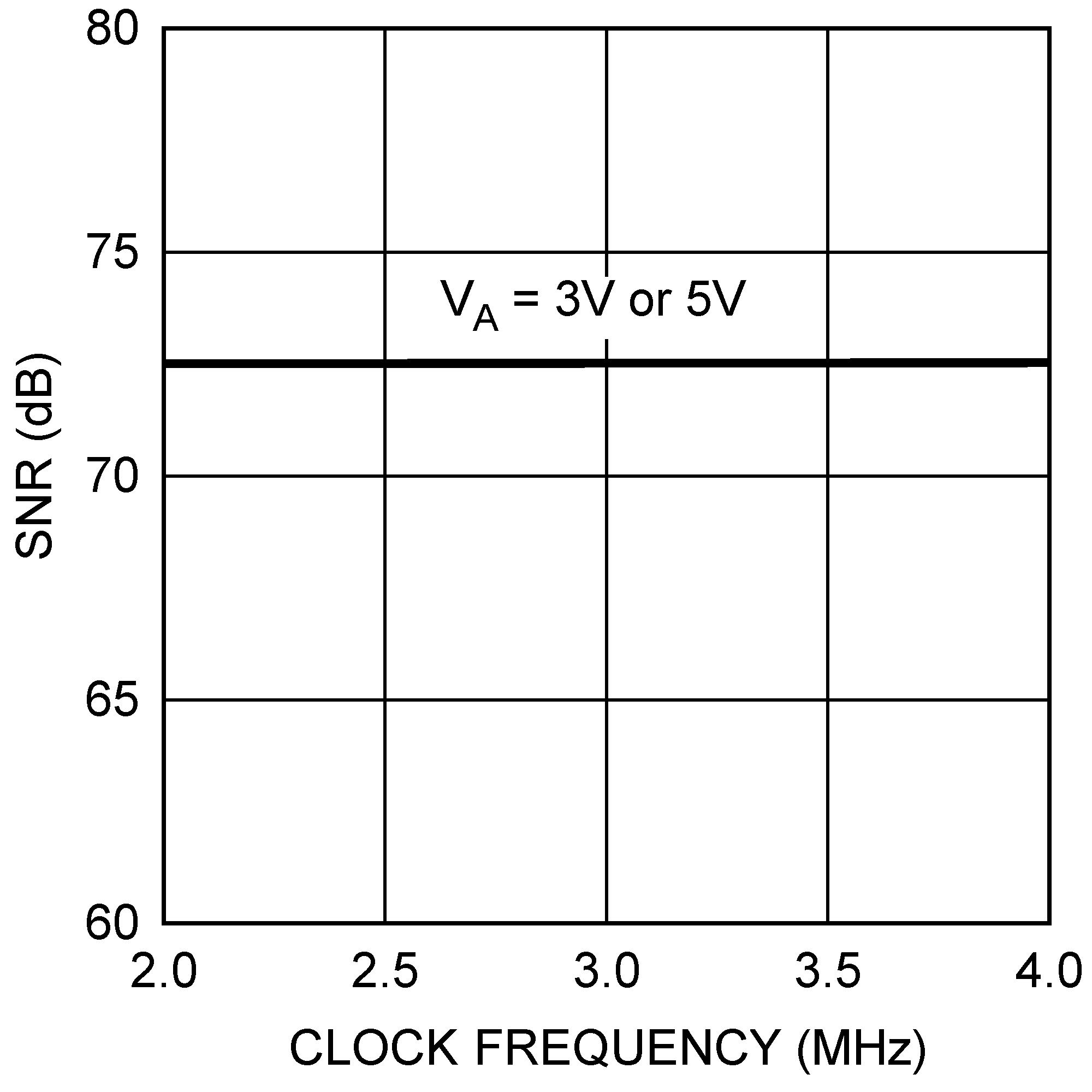 Figure 8. SNR vs Clock Frequency
Figure 8. SNR vs Clock Frequency
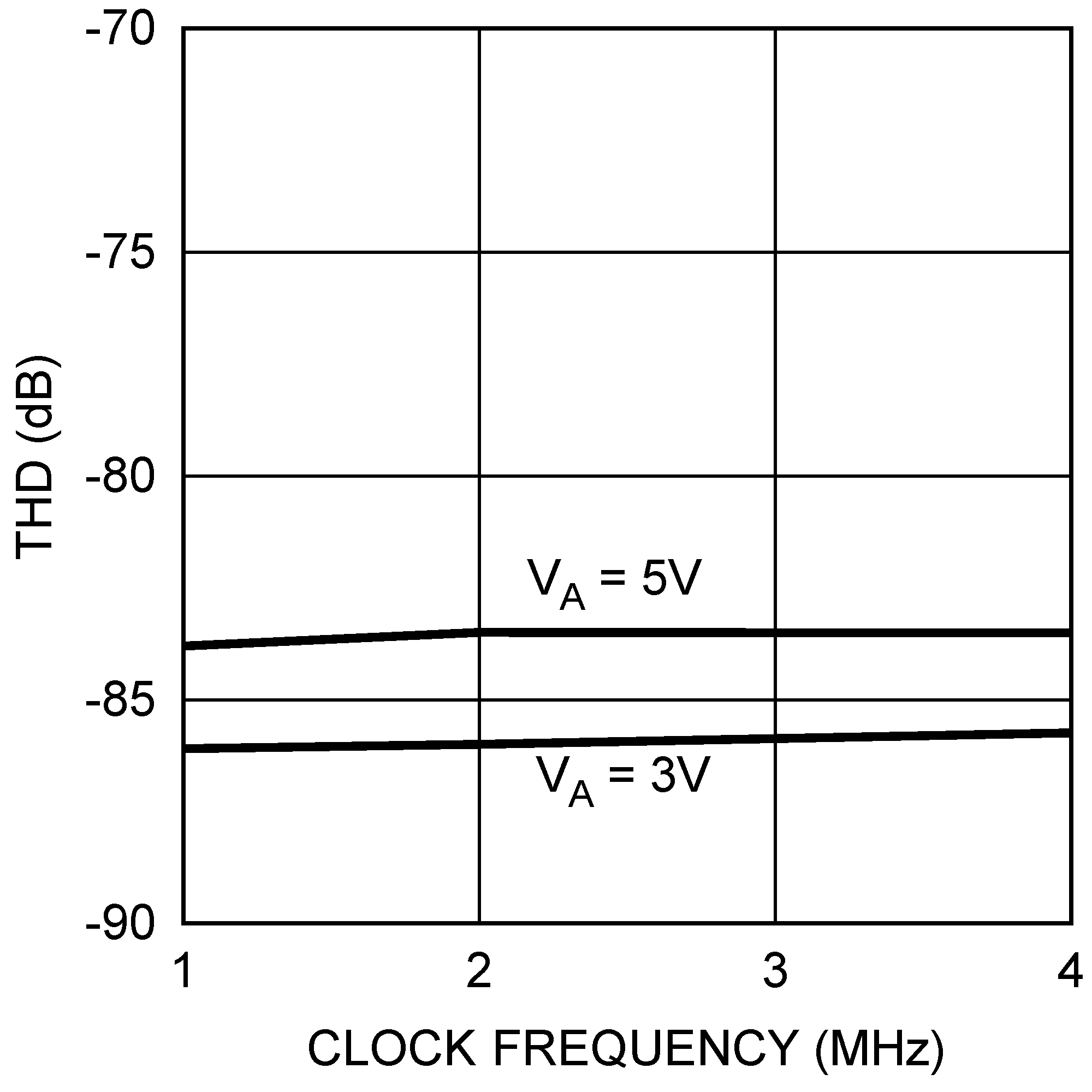
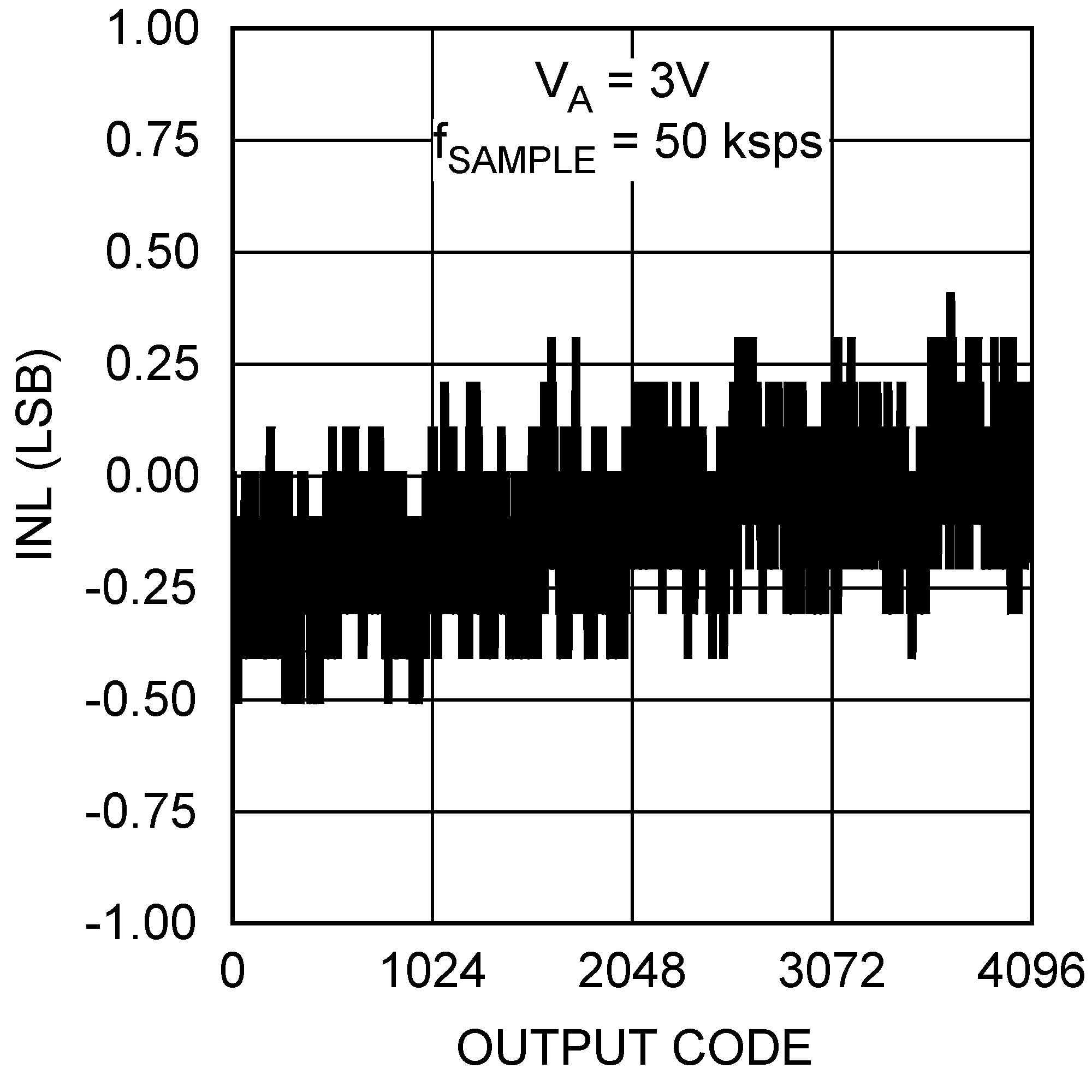
| fSCLK = 1 MHz |
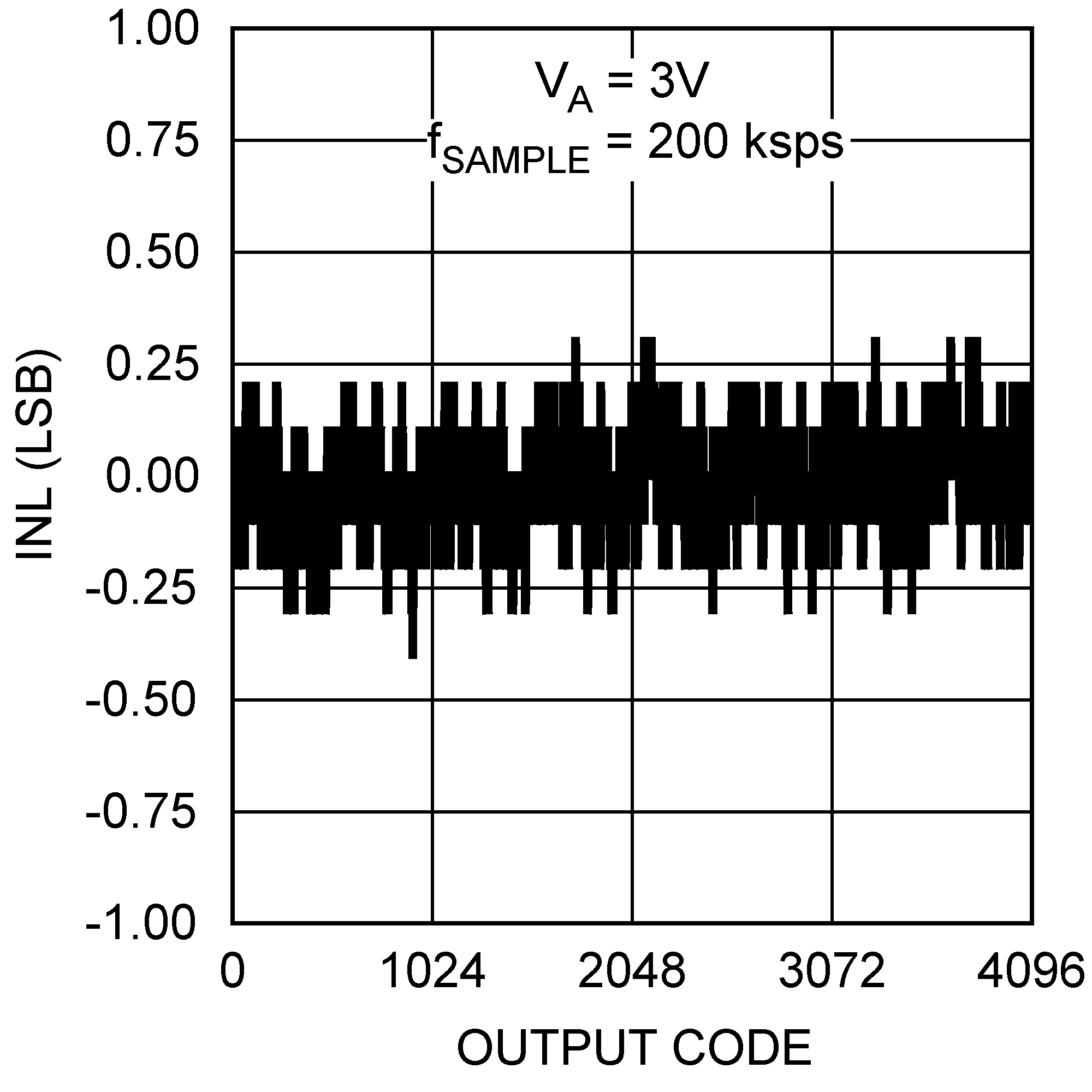
| fSCLK = 4 MHz |
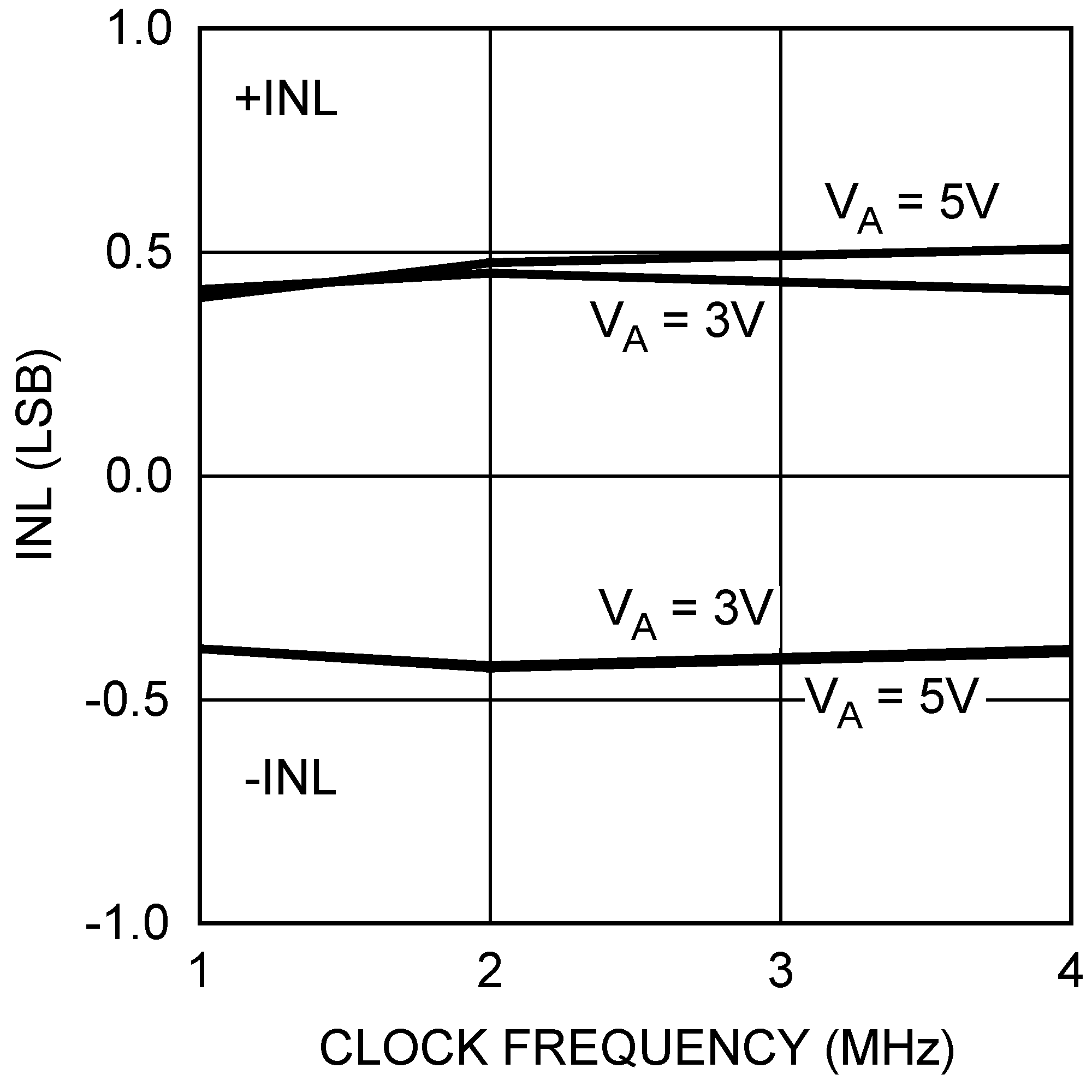 Figure 7. INL vs Clock Frequency
Figure 7. INL vs Clock Frequency
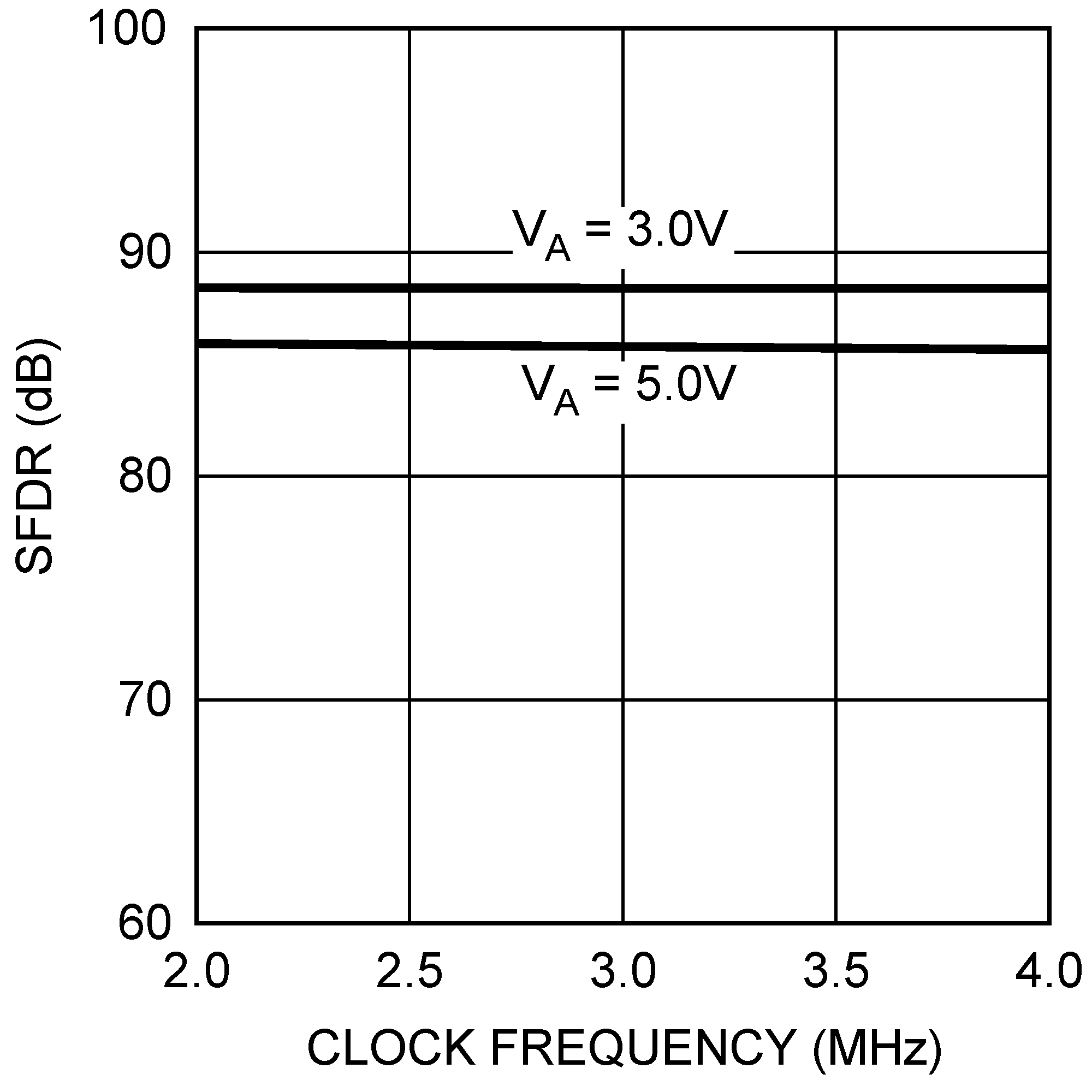 Figure 9. SFDR vs Clock Frequency
Figure 9. SFDR vs Clock Frequency
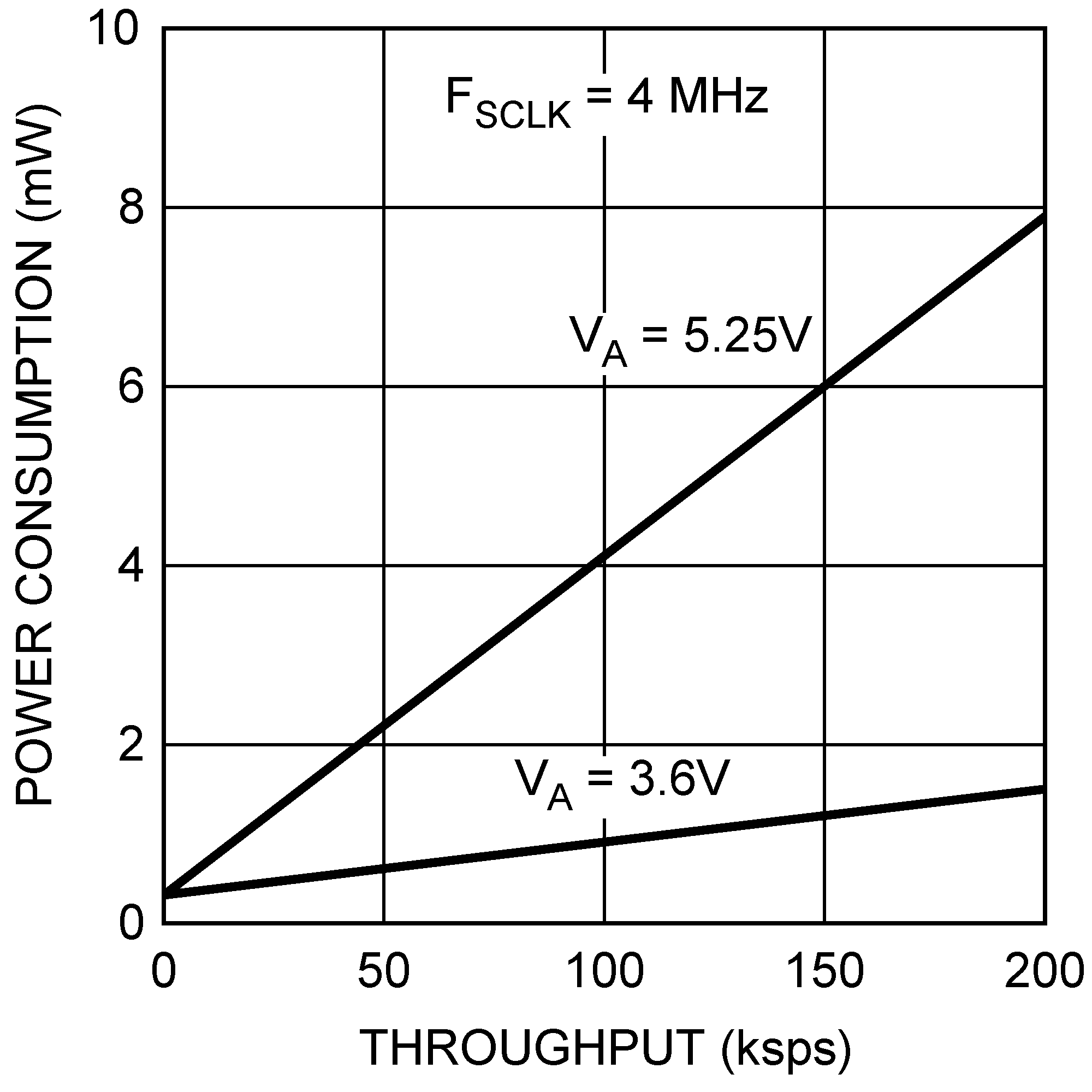
| fSCLK = 4 MHz |